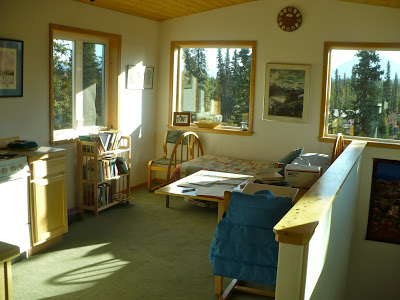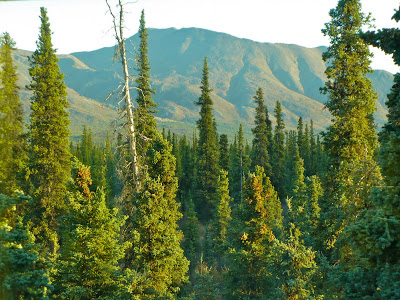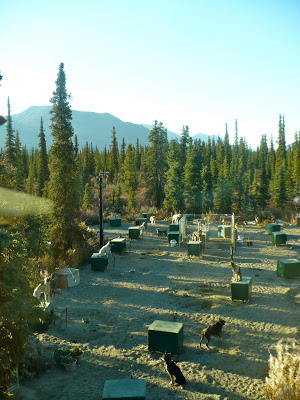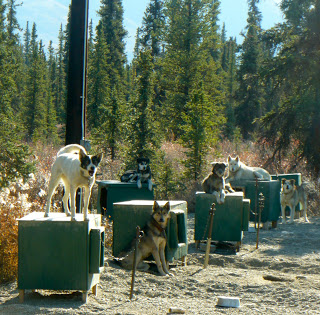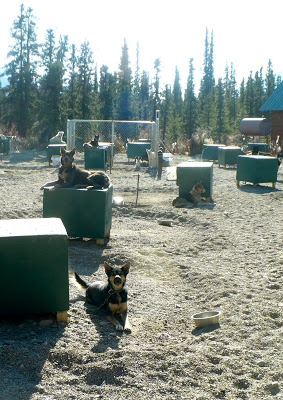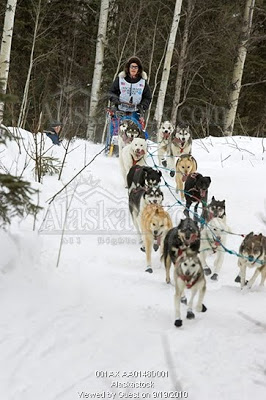AK 2010, Day 39: Meet the Neighbors
Here at Milepost 22w, I’m set up with a lovely loft apartment and views of Pyramid Point and the surrounding 6,000-foot peaks of the Nenana Valley in Denali. A view out just 1 of 9 windows in the loft looks something like this:
A view out another window looks like this:
Or this:
Or this:
That’s right. I’m staying with a family of dog mushers and when I say family, that includes all 37 sled dogs. All but one person here has mushed (and finished) in the famed 1, 150 mile race from Anchorage to Nome. The person who didn’t race? She’s written a History of the Iditarod book, soon to be published by the BLM.
What is this—really—this dog mushing? The short version: Dogs born for endurance, extreme cold weather conditions, loyalty, and leadership find their glory through owners like my gracious host DM and her family. Together, year round, they train to “mush,” or use dog-powered transport in sled-races such as the Iditarod. The dogs run best in cold temperatures—really cold—so miles and miles of this race are run at night, in the dark of an already dark winter, hell bent for Nome and the Bering Sea. As musher Ingabritt Schloven put it:
“If you are ready for it, there is calm…When the sun goes down, you must concentrate. The dark is when the dogs want to hunt and run. The sounds are more intense. It is getting colder. The energy isn’t physical as much as in your head. You can see the mountains around you. And then, above, the northern lights. You see the green and then a swirl…Athabascan natives say the North is where you have room to dream. Here is where the mind can walk. You stop thinking about people and hassles. All that goes away when you are standing on the runners. You are taken with calm. The dogs do the same, I think. It is like when you wake up and a dream stays with you.”
To be fair, much of that dream includes work. Hours of training beforehand, thousand and thousands of dollars in food and gear, preparing hot meals and melting snow for dogs during the race (before you’ve had your own, mind you), pacing yourself and your team (4 hours “rest,” 4 hours racing…approximately), risking your life on thin ice, ice fissures, blind curves or all manner of harness-sled entanglements, tree collisions, moose encounters, and cold-weather ailments. That says nothing of the ritual changing and checking of a dog team’s booties and “peter heaters” (one Iditarod team of about 12 dogs will go through more than 1,000 of these in a 14-day race), planning for mandatory stops and checkpoints along the way, and keeping a constant eye on which dogs should be rotated to lead, team, swing, or wheel positions in the line.
[Here’s my host DM in her 2005 race in a copyrighted Alaska Stock photo]
I’m attempting to write about a fierce sport of which I know very little about. Likewise, an entire genre of nonfiction exists for books of this variety and they are, well, much better than what I can encapsulate here. A word about harnessing dogs from one such author, John Balzar, in Yukon Alone (about the Yukon Quest, the other famous sled race in these parts):
“Harnessing dogs is a task something between rodeo and diaper changing. You grab a collar with a tight-fisted grip, unclip the dog from its chain, and raise its powerful front legs off the ground. People who underestimate the brute-muscle force of these lunging, thrusting creatures have been surprised to pull away with broken fingers. Trying to move a dog with all four feet on the ground permits it the advantage of traction, and you are likely to find yourself dragging on your face…Straddling a squirming, half-berserk dog, you wrestle its head into the harness and then one front food and the other. A loop at the back of each harness is clipped to an individual tugline that veers off the main gangline. Eventually, each pair of dogs will be clipped collar-to-collar with foot-long necklines to keep everybody aligned in the same direction.”
Stay tuned for dog-mushing basics, including a trail run that involves a 4-wheeler and harnesses. I have no idea what this means, but DM says she’ll show me. Here we go!

